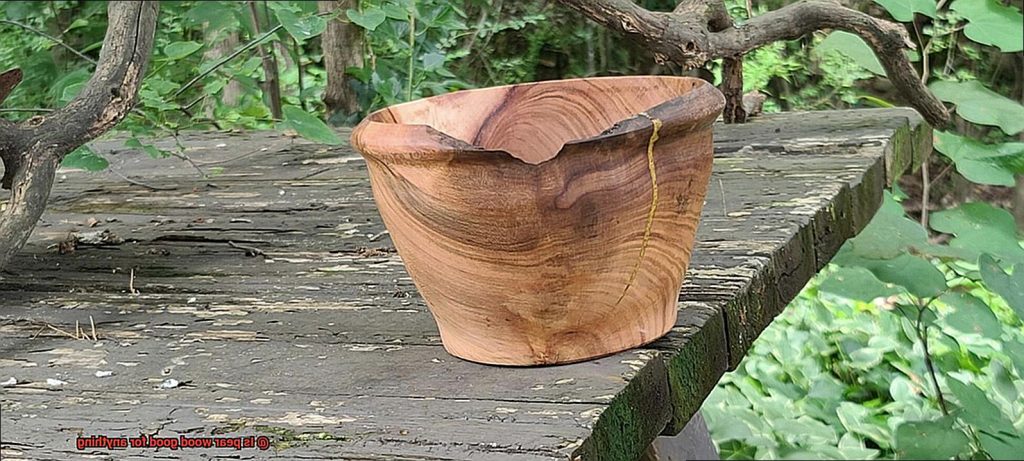Have you ever heard of pear wood? It’s not the most well-known type of wood out there, but it definitely has its own unique set of characteristics and benefits. For centuries, pear wood has been prized for its beauty, strength, and versatility – but is it actually good for anything?
If you’re a woodworking enthusiast, you might want to consider giving pear wood a try. Its softness, even texture, and fine grain make it a favorite among woodworkers. From furniture to decorative items to turned objects, pear wood can be used for just about any project. And if you’re into carving intricate designs and details, pear wood’s tight grain makes it an excellent choice.
But wait – there’s more. Pear wood isn’t just limited to woodworking. In fact, it’s also used as a flavoring agent in smoking food. Who knew that this humble tree species could add such a unique taste to your meals?
And if that wasn’t enough, pear wood is also highly valued within the musical instrument industry. It’s known for producing warm and resonating sounds when used to build guitars, lutes, violins, and other instruments. Its strength and durability allow it to withstand the pressure from the strings without compromising on sound quality.
Overall, pear wood has a lot to offer craftsmen and enthusiasts alike. Whether you’re looking to create beautiful furniture or carve intricate designs or even add some flavor to your next BBQ session – this remarkable wood species should definitely be on your radar. So let’s dive into the origins and properties of pear wood together and uncover all its potential uses.
Contents
Durability and Strength of Pear Wood
Pear wood is a versatile and moderately strong wood that has been used for centuries in various woodworking applications. However, the durability and strength of pear wood depend on several factors, including the age of the tree, growing conditions, and the part of the tree it is harvested from.
Older pear trees produce denser and harder wood, making it stronger and more durable than younger trees. As trees age, their growth slows down, resulting in a more compact and dense wood. Additionally, trees grown in harsher environments or those that have experienced trauma tend to produce denser and stronger wood due to their need to adapt to difficult conditions.
When it comes to the part of the tree used for woodworking, heartwood is typically stronger and more durable than sapwood. The heartwood is the central part of the tree that has stopped actively transporting nutrients, while sapwood is the outermost layer that still carries nutrients throughout the tree.
Pear wood’s moderate strength and durability make it suitable for various woodworking projects such as furniture, cabinetry, and even musical instruments. However, it may not be suitable for heavy-duty applications such as construction or outdoor use without proper treatment or reinforcement.
In addition to its durability and strength, pear wood boasts an attractive grain pattern that makes it perfect for decorative woodworking projects such as carving and veneering. It’s also a popular choice for grilling due to its sweet smoke that adds a delicious flavor to meats, vegetables, and fruits.
Aesthetic Appeal of Pear Wood
Its light color, fine grain, and smooth texture make it a favorite choice for furniture and decorative items. But what is it about pear wood that makes it so alluring? Let’s delve deeper into its aesthetic appeal.
Firstly, let’s talk about the grain pattern. The growth rings on pear wood are intricate and delicate, giving it a unique and highly desirable appearance. The pattern can vary from straight to wavy, which adds to the wood’s charm. When polished or stained, these patterns come alive, creating a stunning effect that is hard to replicate with other types of wood. The distinctive grain pattern of pear wood is what sets it apart from other woods.
But it’s not just the grain pattern that makes pear wood so magnificent. Its smooth texture is also a significant factor. Unlike other woods that can be rough or uneven, pear wood has a silky smooth feel that makes it delightful to touch. This quality also makes it easy to work with, as it can be effortlessly carved or shaped without any resistance. When finished, the wood exudes a soft, radiant glow that is sure to captivate anyone who lays eyes on it.
In addition to its intricate grain pattern and smooth texture, pear wood’s light color is another major factor in its popularity. The bright and airy appearance of pear wood complements many different design styles and can be used in modern minimalist designs or in more traditional settings. Its versatility makes it a popular choice for furniture makers and interior designers alike.
Unique Properties of Pear Wood
Its distinct characteristics set it apart from other types of wood, making it a popular choice for furniture and decorative items.
One of the most remarkable features of pear wood is its fine and even texture. This characteristic makes it a dream to work with as carving and turning are effortless, and sanding gives it a smooth and polished finish. The resulting product looks stunning either stained or left natural.
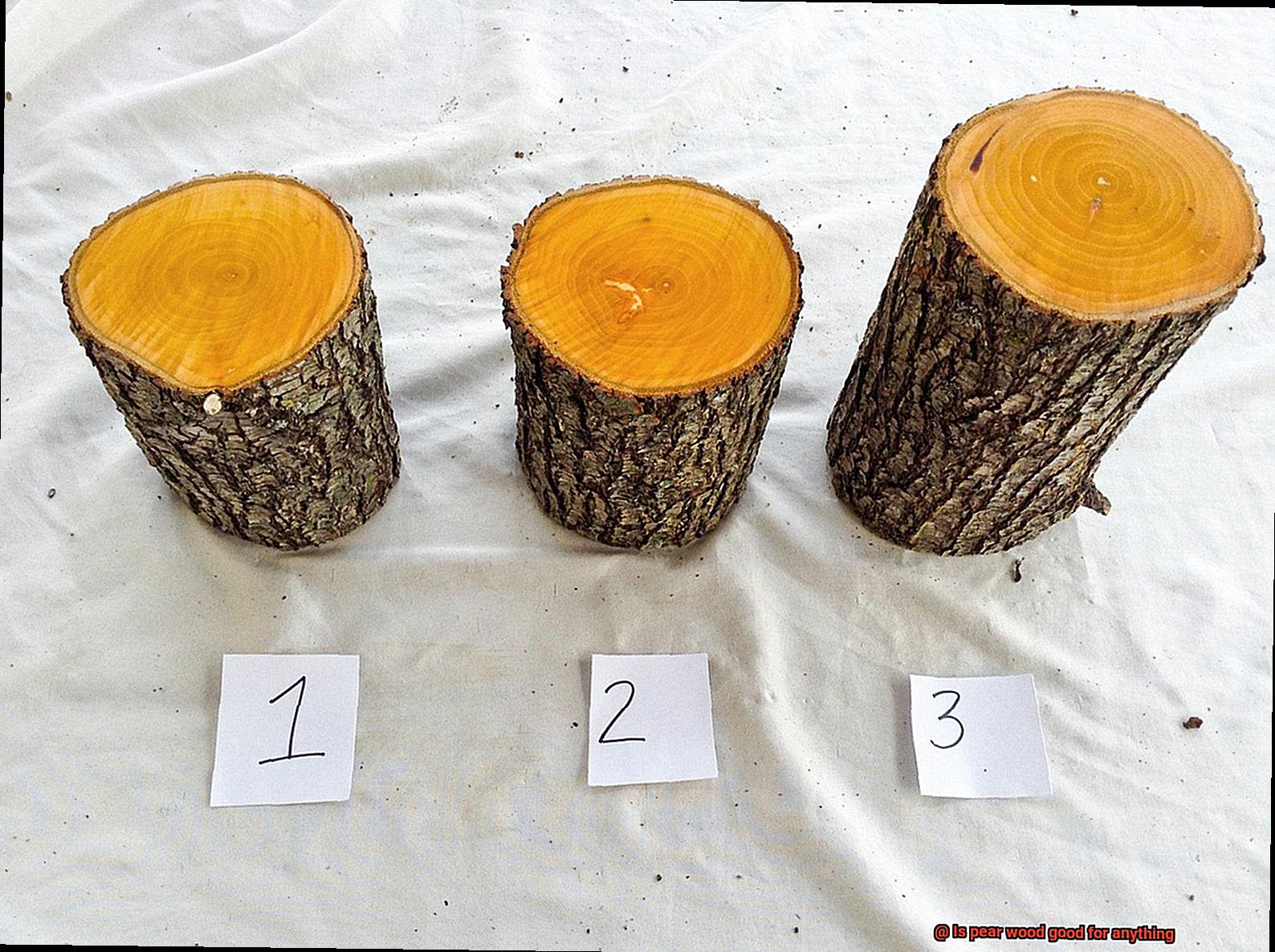
The durability of pear wood is another unique property that makes it stand out among other hardwoods. This dense wood can withstand heavy use, making it perfect for high traffic areas such as flooring, cabinetry, and outdoor furniture. Moreover, its natural resistance to decay and pests make it an ideal choice for outdoor projects.
Pear wood’s beauty lies in its color and grain patterns. With subtle streaks of darker shades, this hardwood ranges from light yellow to reddish-brown, creating a stunning visual effect. The grain pattern is typically straight but can occasionally contain swirls or waves, adding to its uniqueness.
Finally, the sweet aroma that pear wood exudes when cut or sanded is another feature that sets it apart from other woods. This pleasant scent can linger for years, making it an excellent choice for furniture and decorative items that will be used or displayed indoors.
Uses of Pear Wood in Furniture Making
If you’re searching for a wood that is both versatile and durable for your next furniture or musical instrument project, look no further than pear wood. As an expert on the uses of pear wood in furniture making, I can confidently say that it offers numerous benefits.
Pear wood’s fine, even grain and smooth texture make it an ideal choice for intricate carving and decorative work. Its warm color, ranging from pale yellow to reddish-brown, adds visual appeal to any piece of furniture. Chair legs and arms are some of the most common uses for pear wood in furniture making due to its density and strength. It can withstand the weight and pressure of people sitting on chairs without breaking or bending. Furthermore, its stability and resistance to warping make it perfect for table legs and frames.
In addition to structural elements, pear wood is also great for decorative work like inlays, veneers, and carving. When paired with other woods like ebony or mahogany, the contrasts can be stunning. The fine grain of pear wood allows for intricate designs that add a touch of elegance to any piece of furniture.
But that’s not all – pear wood has another unexpected use in musical instrument construction as well. Guitars, violins, and flutes are just a few examples of instruments that benefit from this hardwood’s density and resonance. Its warm tone is a contributing factor to the overall sound quality of the instrument, making it a popular choice among luthiers.
Choosing pear wood for your furniture or musical instrument project not only provides you with a beautiful and durable material but also supports sustainable forestry practices. Pear trees are often grown in orchards for their fruit, so using their wood for other purposes reduces waste and supports local agriculture.
Uses of Pear Wood in Flooring and Cabinetry
Look no further than pear wood. This unique wood is a popular choice in both flooring and cabinetry due to its many benefits.
Let’s start with flooring. Pear wood is known for its stability and resistance to warping, making it an excellent choice for high traffic areas like hallways and living rooms. Its fine, even texture and smooth surface also lend themselves well to sleek and polished design styles. And with the ability to take on stains and finishes beautifully, pear wood can be customized to fit any interior design aesthetic.
Moving on to cabinetry, pear wood’s natural beauty and consistent grain pattern make it a favorite among woodworkers. It’s easy to work with, allowing craftsmen to create elegant and timeless pieces that stand the test of time. And just like with flooring, pear wood’s ability to take on finishes means it can be customized to fit any design style.
But perhaps one of the best things about pear wood is its light, warm tones that create a cozy and inviting atmosphere in any room. Whether you’re looking to add a touch of elegance to your décor or create a welcoming space for family and friends, pear wood is an excellent choice.
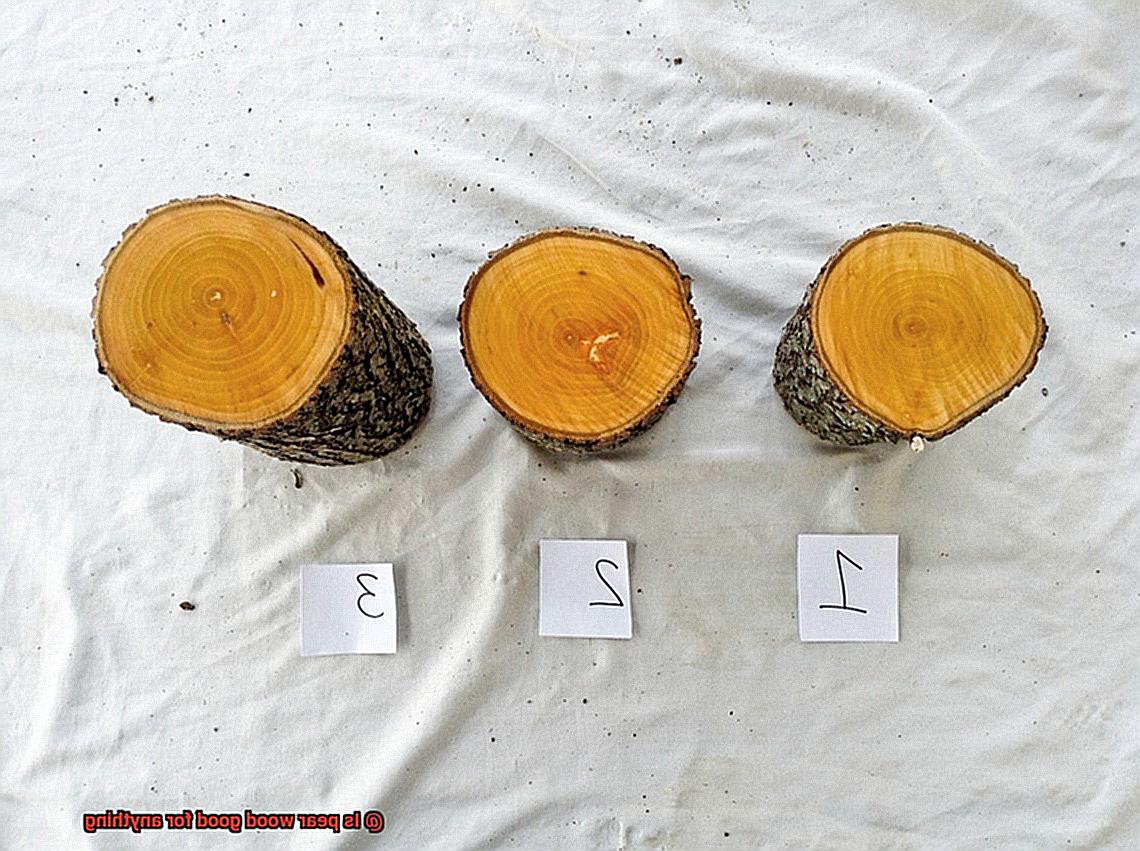
Uses of Pear Wood in Carving, Turning, and Veneering
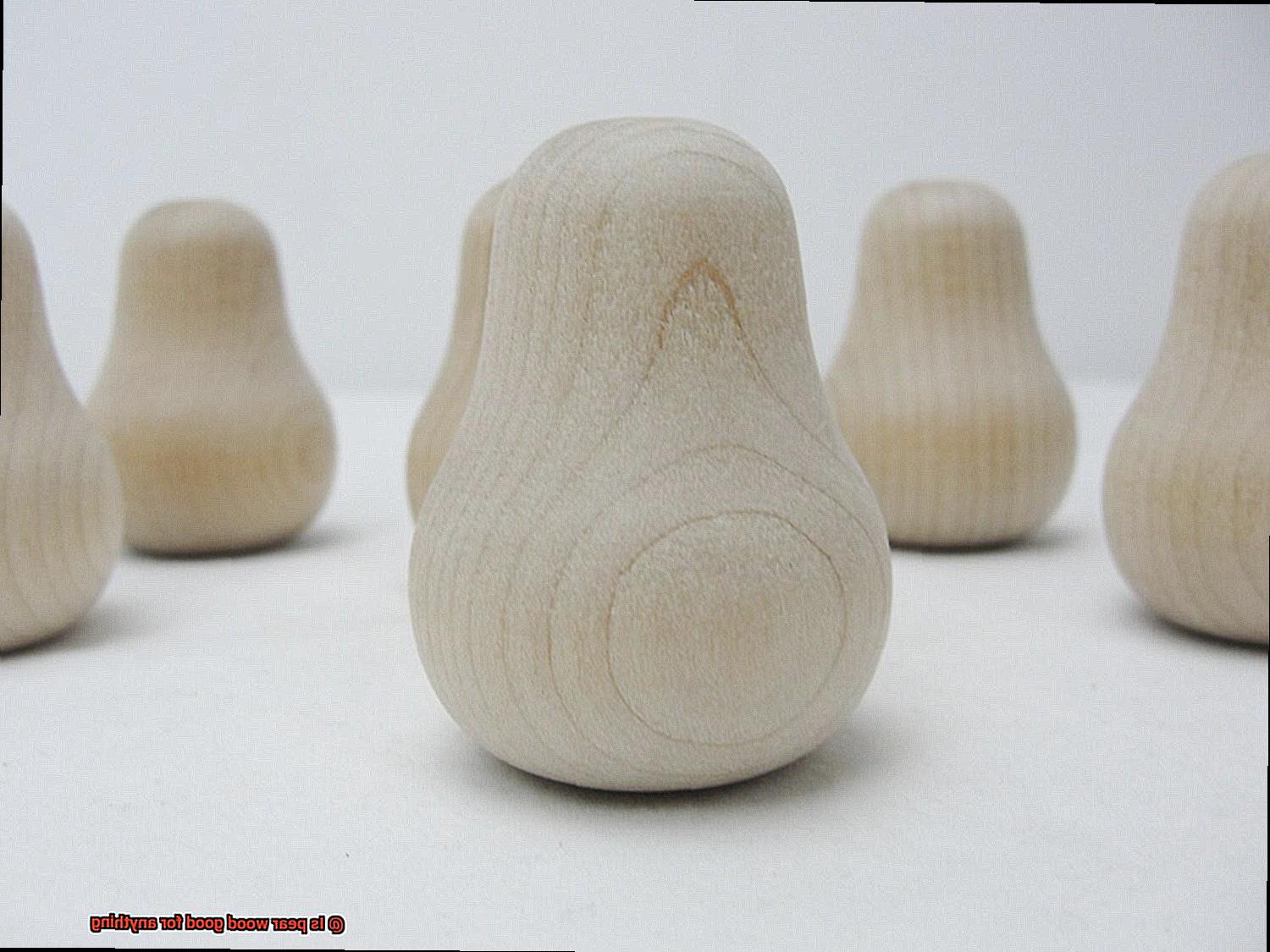
Pear wood is a hidden gem in the world of woodworking, with its versatile nature and unique characteristics that make it a popular choice for carving, turning, and veneering. This fine-grained wood has a smooth texture that makes it easy to work with, and its pale color allows for intricate staining and painting.
Carvers love using pear wood for creating intricate designs and patterns due to its ability to hold detail well. The wood’s smooth texture allows for easy carving, making it an ideal choice for creating decorative carvings. Plus, the pale color of pear wood provides a beautiful base for adding vibrant colors to your carving.
Turners also appreciate the benefits of using pear wood in their craft. This wood is ideal for creating bowls, platters, and vases due to its stability and fine grain. When turned, pear wood has a beautiful finish that highlights the natural beauty of the wood. It’s no wonder why turners love this material so much.
Pear wood is also commonly used in veneering, where it’s often combined with other woods to create decorative patterns or inlays. The wood’s smooth texture makes it easy to cut into thin sheets, and its pale color provides a neutral background that allows other woods to stand out in the design. Veneering with pear wood is an excellent way to add a touch of elegance to your woodworking projects.
Benefits of Using Pear Wood for Grilling
If you’re looking for a new and exciting way to enhance the flavor of your grilled meats, look no further than pear wood. As an expert in the world of grilling, I can confidently say that pear wood offers a unique set of benefits that make it an excellent choice for any grill master.
One of the most significant benefits of using pear wood for grilling is its mild, fruity flavor. Unlike stronger woods like hickory or mesquite, pear wood doesn’t overpower the natural flavors of the meat. This makes it perfect for grilling fish, poultry, and pork, as it enhances the food’s taste without being too strong. Plus, pear wood burns hot and fast, making it ideal for quick grilling sessions.
But that’s not all. Pear wood also produces high smoke output that infuses your food with a delicious smoky taste and aroma. This is especially useful when smoking meats that are typically hard to flavor, like beef or lamb. The rich and flavorful smoke created by pear wood ensures that your food will have a mouth-watering taste and aroma.
Another benefit of using pear wood for grilling is its low ash content. Unlike other woods, pear wood produces relatively low ash content during the grilling process. This means less time spent cleaning up after your grilling session and more time spent enjoying your delicious meal. Additionally, pear wood has a low moisture content, making it easy to light and maintain a consistent temperature throughout the grilling process.
Finally, pear wood is eco-friendly and sustainable. It is widely available in many regions and is often considered a byproduct of orchards that have been harvested for fruit production. Using this wood for grilling is an excellent way to repurpose it and prevent waste while also being environmentally conscious.
Applications for Outdoor Projects with Pear Wood
Get ready to elevate your outdoor projects with pear wood. As an expert in the field, I’ve gathered some compelling research notes that illustrate why pear wood is a must-have material for any outdoor project.
Firstly, pear wood’s durability is unmatched. This hardwood boasts exceptional strength and is highly resistant to decay, making it ideal for outdoor furniture, decking, and structures such as pergolas or trellises. With pear wood, you can enjoy your outdoor creations for years to come.
Not only is pear wood durable, but it’s also visually stunning. Its warm, reddish-brown color and distinct grain pattern give it an elegant appearance that will enhance any outdoor space. And with its ease of use, pear wood is perfect for DIY projects or custom designs.
One exciting application for pear wood in outdoor projects is furniture construction. Thanks to its resilience and resistance to decay, pear wood can be fashioned into long-lasting chairs, tables, benches and more. Its exceptional beauty also makes it a popular choice for high-end outdoor furniture designs.
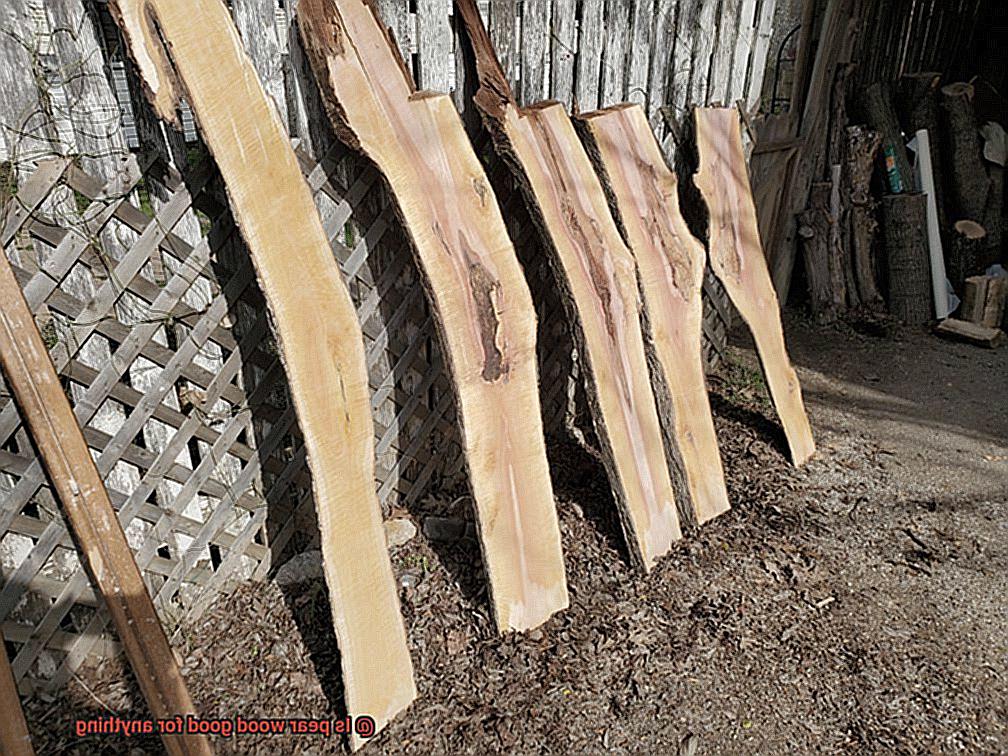
But pear wood isn’t just limited to furniture; it’s also an excellent choice for decking and other outdoor structures. Its strength and resistance to decay make it the perfect material for decking, particularly in areas with high humidity or moisture levels. And let’s not forget about its unique grain pattern that adds a touch of sophistication to any deck design.
YDuOT5r3g6c” >
Conclusion
In summary, pear wood is a true gem in the world of woodworking. Its strength and durability make it an ideal choice for various projects such as furniture, cabinetry, and musical instruments. But what sets pear wood apart from other types of wood is its unique aesthetic appeal – with its light color, fine grain, and smooth texture, it’s no wonder that craftsmen and enthusiasts alike are drawn to this versatile material.
Pear wood’s distinctive qualities also make it a favorite among carvers, turners, veneerers, and grill masters. Carvers appreciate its ability to hold detail well when creating intricate designs and patterns. Turners love working with pear wood as it’s perfect for creating bowls, platters, and vases due to its stability and fine grain. And when it comes to grilling, pear wood offers a fruity flavor that enhances the natural flavors of meat – making it a go-to choice for any BBQ session.
With its exceptional beauty, resilience against decay and pests, as well as its versatility across various projects – pear wood is truly worth considering for your next woodworking endeavor. So why not take a chance on this remarkable wood species?

